

The Corner Office

From Innovation to Enterprise Value: Lessons Mid-Market CEOs Can Steal from Start-Ups
Start-ups move fast because they have no choice. I’ve worked with early-stage healthcare companies building population health platforms, value-based care solutions, and digital wellness models. They didn’t have the luxury of bureaucracy. They had to scale or disappear. That urgency forced them to test, pivot, and measure relentlessly. Mid-market CEOs face a different challenge: complexity

Enterprise Value Creation: The Six Things Only the CEO Can Do
Enterprise value gets talked about in boardrooms all the time — but too often it’s reduced to EBITDA, stock price, or revenue growth. Those matter, but they’re outcomes. True value is built when CEOs align innovation, leadership, and execution so growth is sustainable, repeatable, and transferable. I’ve seen too many mid-market CEOs burn energy on

Are You Focused on the Wrong Things as a Mid-Market CEO?
#6: The Growth Multiplier — Engaging Stakeholders A mid-market CEO once shared with me: “I thought we had a great strategy, but when I rolled it out, our investors pushed back, customers didn’t get it, and employees were confused. I realized I hadn’t brought them along.” That’s the danger of neglecting stakeholder engagement. You can

Are You Focused on the Wrong Things as a Mid-Market CEO?
#5: The Overlooked Growth Lever — Board Effectiveness A CEO once confided in me after a board meeting: “That felt like a waste of time. We spent two hours reviewing financials, half the room barely spoke, and no one challenged our strategy.” That board wasn’t broken. But it wasn’t effective either. And ineffective boards are

Are You Focused on the Wrong Things as a Mid-Market CEO?
#4: The Silent Killer of Growth — Misalignment A mid-market CEO once told me, “We’re moving too slowly. Execution feels stuck.” On the surface, it sounded like a strategy or operations problem. But as I dug in, I discovered the real issue: the company wasn’t aligned. Each leader had their own priorities. Culture was described

Are You Focused on the Wrong Things as a Mid-Market CEO?
#3: Your Vision Isn’t Clear Enough High turnover. Low engagement. Leaders working hard—but not on the right things. These are symptoms of a deeper issue: lack of Vision Clarity. Without a compelling vision, execution scatters, culture drifts, and growth leaks value every day. The Enterprise Value Impact Companies with clear vision grow 58% faster, achieve

Are You Focused on the Wrong Things as a Mid-Market CEO?
#2: Your First Team Doesn’t Work Like One You walk into executive team meetings expecting alignment—and instead get polite updates, turf wars, and half-hearted consensus. That’s not a First Team. That’s a group of silo leaders pulling in different directions. And when your First Team fractures, execution fragments. Growth bottlenecks. Enterprise value erodes. The Enterprise

6 Signs You’re Focused on the Wrong Things as a Mid-Market CEO?
#1: You’re Stuck In the Business—Not Leading On the Business Leading a mid-market company is exhilarating—and exhausting. But here’s the hard truth: when you spend most of your time in tactical meetings, operational firefighting, and decision fatigue, you’re not leading—you’re surviving. And survival mode leaks value. Productivity slows. Strategic bets stall. Leaders disengage. The Enterprise

6 Steps to Building a BOLD 2029 Plan for Growth
I was with a mid-market CEO recently who said: “Every year our planning feels like a financial exercise. We sit around the table, tweak the budget, and call it strategy.” That’s not strategy. And it’s not how you build enterprise value. If you want to grow with intention, your plan for 2029 — and your

10 Strategic Questions Every CEO Should Ask to Prepare for 2026
A CEO told me recently: “We always end the year with good intentions, but by the time we finalize our plan, Q1 is already slipping away. We spend more time catching up than leading.” That’s the danger of waiting too long. If you want to create enterprise value in 2026, you can’t afford to coast




